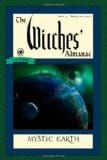
 The Witches’ Almanac, Issue 33 Spring 2014-2015: The Mystic Earth, edited by Andrew Theitic
The Witches’ Almanac, Issue 33 Spring 2014-2015: The Mystic Earth, edited by Andrew Theitic
The Witches’ Almanac, 9780982432396, 208 pp. (incl. letters, ads), 2013
Reading The Witches’ Almanac is like going to a favourite restaurant and ordering all of the appetizers and two desserts for dinner: you get a dazzling array of different tastes, but with no single dish too filling.1
The Almanac has been steadily growing over the years. Early issues were 90 or so pages, stapled in soft card covers like the typical Farmer’s Almanac; recently it has graduated to a typical trade paperback: 9×6-inch, 208 pages, perfect-bound, glossy cover. This helps make their front-cover motto, “Ever a Keepsake,” realizable.
This year’s theme is “Mystic Earth,” returning to the theme of no. 30, though this time from a different angle. Unfortunately the cover art, with the Earth seen from space in a palette of greens, blues, deep-space black, and incongruous cream text-box backgrounds, ranks as the least-appealing in a long time, although I like the idea of doing something modern occasionally.
Inside you’ll find 65 articles with a good mix of folklore, practical advice, and esoterica. “A Witch’s Garden” looks at planning and planting an herb garden in a reverent and inspiring way. Several short features on herb lore and other earthy topics from respected Druid Ellen Evert Hopman carry the theme into the rest of the book. The closest thing to a single article that matches the theme, though, is Jimahl di Fiosa’s “The Magic of Camping,” which, like the one above, is full of hints for doing this common activity mindfully and reverently, as well as in a safe and organized manner. He’s not Pollyanna about his topic though, in the last paragraph he advises, “If it all goes terribly wrong, then at least you can say you’ve tried it.”
The astrological calendar that serves as the book’s framework is delightful as usual. It contains bits of magical advice (varying from the obvious “wear solar colours” on a Sunday to the obscure-but-inspired “Assemble at the Crossroads” on February 27th), birthdays of famous people (including Noah Webster, Jonas Salk, chess champion J. R. Capablanca, and rocket scientist and magus Jack Parsons).
This issue also contains pointers to Hermetic and high-magical information. Anthony Teth has a piece on Hermes Trismegistus and another on Enochian. The former is quite excellent, but it leaves us thinking that the 17th-century demonstration by Isaac Casaubon that the text of The Hermetica translated by Ficino is the last word on their antiquity, which is not quite true. For example, there’s Jacob Slavenburg’s The Hermetic Link,2 which is a good overview. We are also treated to a cogent account by Robert Mathiesen (who wrote introductions to the new Aradia3 and The Witchcraft of Dame Darrell of York for the Almanac Press) of the evolution of the confusing terminology of “Devils, Demons, and Angels.”
Another piece by Dikki-Jo Mullins visits the topic of “Veiling” (usually meaning head covering) among modern Pagans. This has received some attention online in the last year or so, and Mullins notes that there was a presentation on it at the last Florida Pagan Gathering. I showed this to my wife, who was among the first Pagans to make a practice of head-covering for energetic reasons, and she jokingly turned all Hipster Priestess, “I was into that before it was a thing.” She also pointed out that the article gave only the briefest mention of some of the actual reasons for veiling, but then simply ended, leaving the reader to wonder.
Turning to other highlights of the issue, we have Dikki-Jo Mullins’s latest in a series on the fixed stars, covering Alpheratz (Alpha Andromedae). This one is somewhat significant in my natal chart, so I will use the article as a jumping-off point for better acquaintance with this star. It is not one of the Behenians or Royals, so I had not looked at it yet, but it is one of William Lilly’s recommended fifty stars to consider in horary delineations. My take on using the fixed stars is that it provides a strong link to traditional and esoteric astrology, and also makes a bridge between tropical (seasonal) and sidereal (constellational) systems.
On segmented sleep, a topic that has received a bit of attention recently, Lee Morgan writes about sleep over the centuries in “Nighttime Mind.” I shall have to see if I can get anything out of his recommendations, mainly of trying a post-twilight artificial light fast occasionally. Yes, that would mean turning off the computer!
Don’t miss the essays by the late Barbara Stacy on “Scheherazade” and “The Library of Alexandria.” The content is balanced and accurate, and I found the style worth lingering to appreciate.
All in all, this may be the best Almanac yet. I said that last year, didn’t I? It does such a good job of having something for everyone, and there always a few articles that send you to the library, or at least to a search engine.
- Reviews of previous almanacs are available on Freeman’s blog here: 2013, 2012. [↩]
- Click for Freeman’s review of The Hermetic Link. [↩]
- Click to read Psyche’s review of Aradia. [↩]







